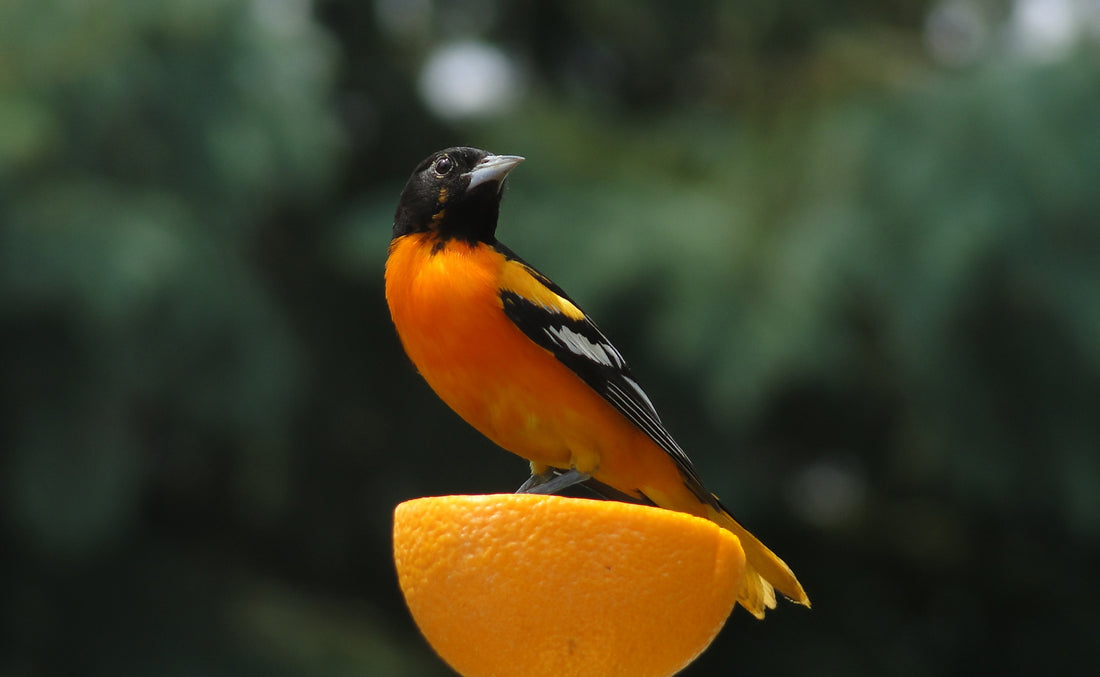
Breaking Down the Different Types of North American Orioles
Share
All About New World Orioles: Altamira Oriole, Audubon’s Oriole, Baltimore Oriole, Bullock's Oriole, Hooded Oriole, Orchard Oriole, Scott's Oriole, and Spot-Breasted Oriole
Found in the Americas, Canada, and occasionally in the Caribbean Islands, Orioles are stunning songbirds in a class of their own. The original Orioles in Europe were aptly named for their golden hue, but those species have since become known as Old World orioles. American Orioles, also known as New World Orioles, are completely different. Part of the blackbird family, these highly intelligent birds are distinct in beauty, their unique diets, and their migration patterns.
Altamira Oriole
Icterus gularis

As the largest oriole found in the U.S., the Altamira Oriole is a stout bird with a pointed bill. Both adult male and females have a bright orange body and head with a black back, tail, and wings. The Altamira Oriole’s range is mostly south of the U.S. border along the Lower Rio Grande Valley of Texas. Although the Texas Organization for Endangered Species label them as “threatened” within the state, the Altamira Oriole is still relatively common.
Audubon’s Oriole
Icterus graduacauda

Previously known as the Black-headed Oriole, Audubon’s Orioles can be found among dry forests and brush. This bird is the only type of oriole that sports a black hood, giving it the distinction from its other oriole kin. Its characteristic rising-and-falling whistle is a clear indicator that this bird is near.
Baltimore Oriole
Icterus galbula

As Maryland’s state bird since 1947 and the namesake of Maryland's MLB Baseball team, the Baltimore Oriole has a voracious appetite for caterpillars, insects, and fruit. Although it has a population of 12 million in the U.S. and Canada, this beautiful bird’s presence is unfortunately decreasing throughout the continent; in fact, over the past 50 years, the Baltimore Oriole population has decreased by 42%, making it exceedingly rare. If you are lucky enough to spot one, hopefully it will be on one of their intricately-woven Oriole nests, which can carry up to seven eggs and last months after nestlings have hatched.
Bullock’s Oriole
Icterus bullockii


Baltimore Orioles breed across the eastern and Midwestern parts of the US, whereas Bullock Orioles are primarily found in the West.
Once considered the same as Baltimore Orioles, Bullock’s Orioles are their own species that earned their distinction in the 1800s from William Bullock, an amateur English naturalist. Despite also having a decreasing population, these birds are the most widespread orioles in the western part of the United States.
Hooded Oriole
Icterus cucullatus

The palm-leaf Oriole gets its nickname from its tendency to nest in palm trees. Although the Hooded Oriole’s population is a mere 350,000 in the U.S., it is steadily increasing. Hooded Orioles have an ever-expanding range north, and have been spotted in the open woods, shade trees, and of course palms of northern California.
Orchard Oriole
Icterus spurius

The Orchard Oriole is distinguishable from other orioles for its darker, burnt-orange hue and small size. Orchard Orioles migrate north in late spring. This species is notoriously easygoing as compared to other songbirds, and nests nearby to Baltimore Orioles, American robins, and Chipping sparrows. Don’t mistake their chill nature for them being pushovers, however; these birds are known for aggressively warding off predators and cowbirds.
Scott’s Oriole
Icterus parisorum
Scott’s Oriole may not look all that unique, but this bird is one-of-a-kind for its eating habits. These birds prey upon Monarch butterflies in particular, in addition to other insects, fruit, and nectar. Unlike many other wild birds, Orioles do not eat seeds, so feeding them a traditional wild bird feed mix simply won’t do. Instead, try mealworms! A pro tip for attracting orioles to backyards is to slice an orange in half and put it in a tree. You can also make a DIY Oriole feeder by putting a bowl of grape jelly in a plastic bowl and hanging it on the end of a sturdy branch.
Bluebird & Oriole Buffet Bird Feeder $22.80
Spot-breasted Oriole
Icterus pectoralis

Native to southern Mexico and Central America, birders in the U.S. can now find the Spot-Breasted Oriole in the lush suburban gardens of South Florida, primarily Miami and West Palm Beach. They may look similar to other Orioles, but the Spot-breasted species is unique with its black spotting on the breast and white streaks on its wings.
Valley Farms Natural Dried Mealworms 1LB $15.80
Find all the bird feeders and wild bird feed mixes you need to keep Orioles happily whistling along when you shop with us at Valley Farms®!


